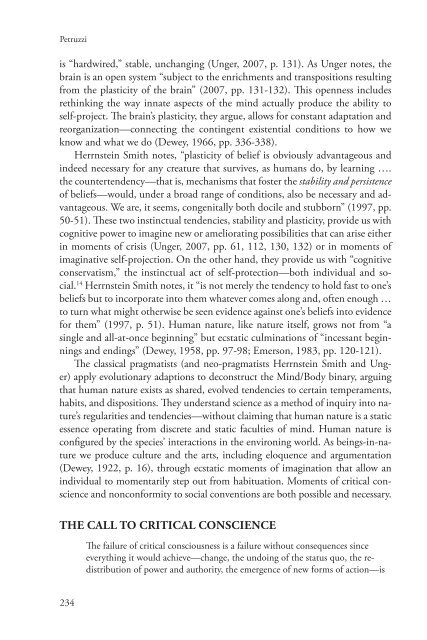Critical Expressivism- Theory and Practice in the Composition Classroom, 2014a
Critical Expressivism- Theory and Practice in the Composition Classroom, 2014a
Critical Expressivism- Theory and Practice in the Composition Classroom, 2014a
Create successful ePaper yourself
Turn your PDF publications into a flip-book with our unique Google optimized e-Paper software.
Petruzzi<br />
is “hardwired,” stable, unchang<strong>in</strong>g (Unger, 2007, p. 131). As Unger notes, <strong>the</strong><br />
bra<strong>in</strong> is an open system “subject to <strong>the</strong> enrichments <strong>and</strong> transpositions result<strong>in</strong>g<br />
from <strong>the</strong> plasticity of <strong>the</strong> bra<strong>in</strong>” (2007, pp. 131-132). This openness <strong>in</strong>cludes<br />
reth<strong>in</strong>k<strong>in</strong>g <strong>the</strong> way <strong>in</strong>nate aspects of <strong>the</strong> m<strong>in</strong>d actually produce <strong>the</strong> ability to<br />
self-project. The bra<strong>in</strong>’s plasticity, <strong>the</strong>y argue, allows for constant adaptation <strong>and</strong><br />
reorganization—connect<strong>in</strong>g <strong>the</strong> cont<strong>in</strong>gent existential conditions to how we<br />
know <strong>and</strong> what we do (Dewey, 1966, pp. 336-338).<br />
Herrnste<strong>in</strong> Smith notes, “plasticity of belief is obviously advantageous <strong>and</strong><br />
<strong>in</strong>deed necessary for any creature that survives, as humans do, by learn<strong>in</strong>g ….<br />
<strong>the</strong> countertendency—that is, mechanisms that foster <strong>the</strong> stability <strong>and</strong> persistence<br />
of beliefs—would, under a broad range of conditions, also be necessary <strong>and</strong> advantageous.<br />
We are, it seems, congenitally both docile <strong>and</strong> stubborn” (1997, pp.<br />
50-51). These two <strong>in</strong>st<strong>in</strong>ctual tendencies, stability <strong>and</strong> plasticity, provide us with<br />
cognitive power to imag<strong>in</strong>e new or ameliorat<strong>in</strong>g possibilities that can arise ei<strong>the</strong>r<br />
<strong>in</strong> moments of crisis (Unger, 2007, pp. 61, 112, 130, 132) or <strong>in</strong> moments of<br />
imag<strong>in</strong>ative self-projection. On <strong>the</strong> o<strong>the</strong>r h<strong>and</strong>, <strong>the</strong>y provide us with “cognitive<br />
conservatism,” <strong>the</strong> <strong>in</strong>st<strong>in</strong>ctual act of self-protection—both <strong>in</strong>dividual <strong>and</strong> social.<br />
14 Herrnste<strong>in</strong> Smith notes, it “is not merely <strong>the</strong> tendency to hold fast to one’s<br />
beliefs but to <strong>in</strong>corporate <strong>in</strong>to <strong>the</strong>m whatever comes along <strong>and</strong>, often enough …<br />
to turn what might o<strong>the</strong>rwise be seen evidence aga<strong>in</strong>st one’s beliefs <strong>in</strong>to evidence<br />
for <strong>the</strong>m” (1997, p. 51). Human nature, like nature itself, grows not from “a<br />
s<strong>in</strong>gle <strong>and</strong> all-at-once beg<strong>in</strong>n<strong>in</strong>g” but ecstatic culm<strong>in</strong>ations of “<strong>in</strong>cessant beg<strong>in</strong>n<strong>in</strong>gs<br />
<strong>and</strong> end<strong>in</strong>gs” (Dewey, 1958, pp. 97-98; Emerson, 1983, pp. 120-121).<br />
The classical pragmatists (<strong>and</strong> neo-pragmatists Herrnste<strong>in</strong> Smith <strong>and</strong> Unger)<br />
apply evolutionary adaptions to deconstruct <strong>the</strong> M<strong>in</strong>d/Body b<strong>in</strong>ary, argu<strong>in</strong>g<br />
that human nature exists as shared, evolved tendencies to certa<strong>in</strong> temperaments,<br />
habits, <strong>and</strong> dispositions. They underst<strong>and</strong> science as a method of <strong>in</strong>quiry <strong>in</strong>to nature’s<br />
regularities <strong>and</strong> tendencies—without claim<strong>in</strong>g that human nature is a static<br />
essence operat<strong>in</strong>g from discrete <strong>and</strong> static faculties of m<strong>in</strong>d. Human nature is<br />
configured by <strong>the</strong> species’ <strong>in</strong>teractions <strong>in</strong> <strong>the</strong> environ<strong>in</strong>g world. As be<strong>in</strong>gs-<strong>in</strong>-nature<br />
we produce culture <strong>and</strong> <strong>the</strong> arts, <strong>in</strong>clud<strong>in</strong>g eloquence <strong>and</strong> argumentation<br />
(Dewey, 1922, p. 16), through ecstatic moments of imag<strong>in</strong>ation that allow an<br />
<strong>in</strong>dividual to momentarily step out from habituation. Moments of critical conscience<br />
<strong>and</strong> nonconformity to social conventions are both possible <strong>and</strong> necessary.<br />
THE CALL TO CRITICAL CONSCIENCE<br />
The failure of critical consciousness is a failure without consequences s<strong>in</strong>ce<br />
everyth<strong>in</strong>g it would achieve—change, <strong>the</strong> undo<strong>in</strong>g of <strong>the</strong> status quo, <strong>the</strong> redistribution<br />
of power <strong>and</strong> authority, <strong>the</strong> emergence of new forms of action—is<br />
234


















